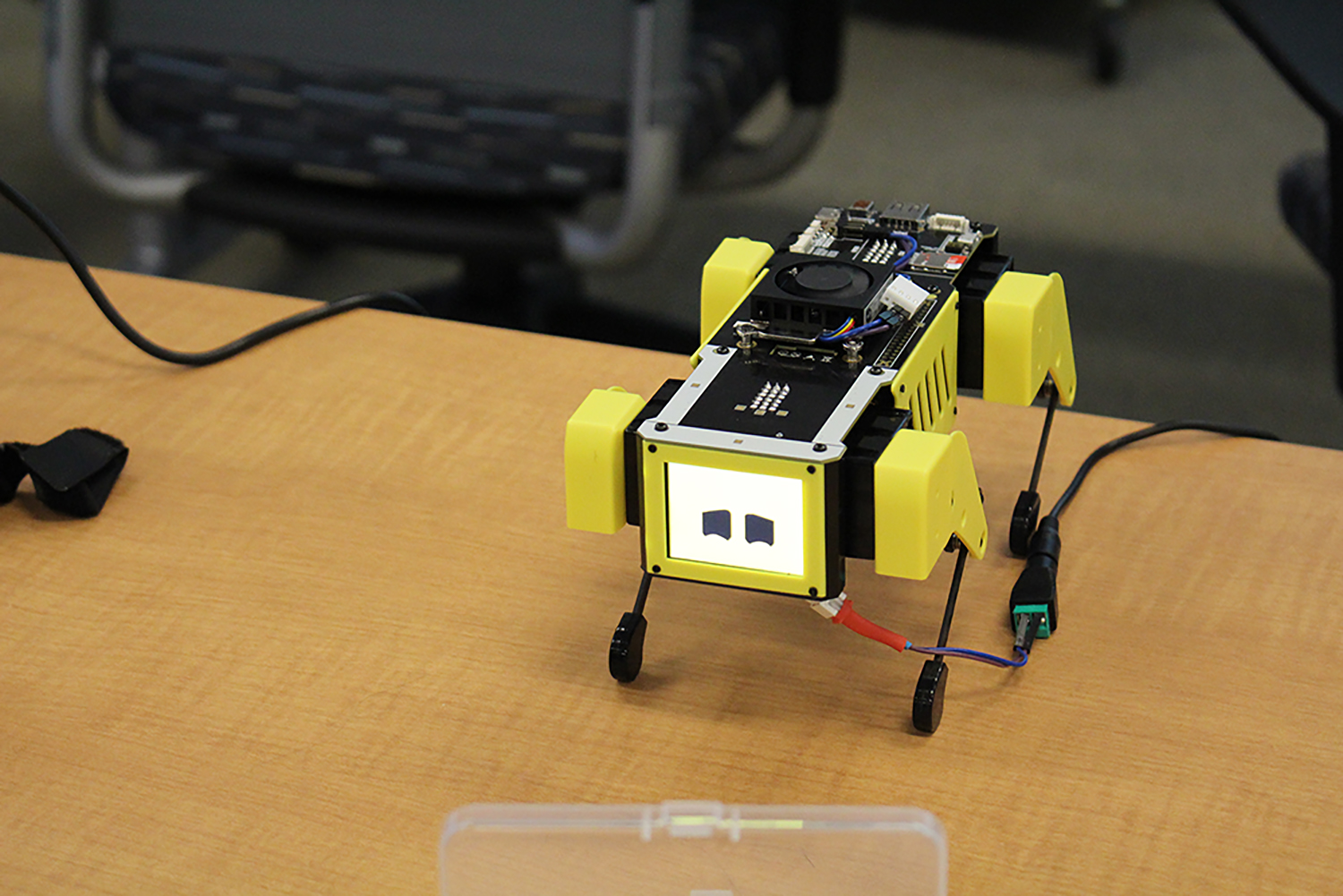Having just completed its second semester as a course offering in the College of Engineering, ECE 3432 Robotic Control Using ROS has already undergone various curriculum upgrades with more planned for next year. The constant upgrades are all part of the plan to keep the course at the forefront of robotics and artificial intelligence education.
Utilizing the Mini Pupper robot from the MangDang company based in Hong Kong, ECE 3432 guides students through programming the Mini Pupper robot to complete autonomous movements with remote control.
Li Bai, Chair and Professor in the Electrical and Computer Engineering Department, was at an engineering conference for Amazon Web Services when he first learned of the potential for the Mini Pupper robots in the classroom. Bai was already teaching students programming through the AWS cloud software, but the Mini Pupper robots provided a way for students to see the physical aspect of their programming as well as provide an artistic element to the technical work in the form of a robotic dance routine project.
Aiming to set the course up over the 2023 summer break, Bai ran into his first obstacle early on.
“The robots cost about $1,000 each and I was looking for what the best way was to purchase the robot, because it’s not a small amount of money,” he explained.
After presenting his course idea, he received approval to use the Electrical Engineering Department Gift Fund. Through these funds he was able to purchase a Mini Pupper robot to test. Seeing how well the robot ran, Bai decided to move forward with the course, where he encountered his next obstacle: providing robots for the students.
In other robotics classes, students typically utilize a digital simulator to practice programming. However, Bai wanted students to get hands-on experience, working through the trial-and-error issues that come with robotics.
“How do you mount the robot legs? How physically and mechanically do the motors move? That will give a student the real feeling of what they’re learning in class. That will translate to something in the real robotic application,” Bai elaborated.
Not wanting to pass the $1,000 cost of the robot on to the student in the form of lab fees, Bai revisited the Electrical Engineering Department Gift Fund to explore ways to reduce student costs by purchasing unassembled parts at a discounted price. He enlisted his 3+2 student, Brian Chang, to handle the reassembly and implement the necessary robot revisions. Thanks to generous donations, there were enough funds for Bai to acquire several robots for the course. Grouping students into teams of two, each team was able to use one Mini Pupper robot for the duration of the semester.
Working with a physical robot provided the exact student experience that Bai intended. Chris Pullen, now a graduate student completing his master's in mechanical engineering as part of the +1 program, took the course as a student in the fall of 2023. Finding the course engaging and enjoyable, he jumped at the opportunity to work with Bai as a Graduate Research Assistant to improve the course.
Having taken a robotics course that utilized a virtual robot simulator and Bai’s course with the physical robot, Pullen immediately recognized the benefit the physical robot had on his learning comprehension.
“If you put a few hours into making a dance routine you actually get to see that dance routine happen in the robot when you go to present that project, which is pretty fulfilling,” Pullen elaborated.
Over the next semester and 2024 summer break, Bai spent more time exploring the capabilities of the Mini Pupper robot and AWS software. Partnered with Pullen’s suggestions as a former student, the two incorporated updates to the curriculum.
Instead of just a programmed dance by the robot as the final exam they incorporated additional robotic capabilities, such as rotating and color recognition, to have the Mini Pupper robot complete a line following exercise. In addition to having the robot autonomously follow the line, students needed to program the robot to recognize colored shapes placed along the line and complete the corresponding action such as a dance move or spin moves.
Pullen cites the project-based nature and the hands-on experience that made this course so impactful on his undergraduate experience.
Part of the Fall 2024 winning senior design team, Camera Tracking System (Rat-Trac), he used many of the concepts he learned in this course and applied them directly to the project. Now a robotics instructor at Coco Academy in Philadelphia, Pullen uses both his robotics knowledge and teaching knowledge gleaned from the course in his everyday work.
Even with the success of the first two years teaching ECE 3432, Bai is looking for more ways to improve the course and expand about the concepts taught. For Fall 2025 he’s considering including a module that has students aseemble the physical parts of the robot, not just programming.
The success and impact of this course relies on the Electrical Engineering Department Gift Fund, comprised entirely of donations from generous alumni, faculty and other supporters. Without these donations, Bai wouldn’t have been able to purchase robots for students to use or keep up with any needed repairs.
Bai shares, “every dollar counts. At the end of the semester, even though the robot is well built, the servomotor can break. Each servomotor is roughly $10. We don’t want to charge this kind of stuff back to the students. If the department can have the resource and the money, we’d like to cover that.”

